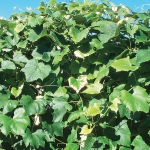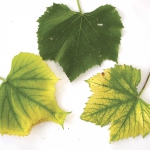Applying irrigation to Concord juice grape vineyards early in the growing season can delay soils from warming and could trigger chlorosis symptoms, says a Washington State University soil scientist.

Dr. Joan Davenport
Concord chlorosis is an age-old problem in eastern Washington juice grape vineyards. The disorder is typified by yellowing of leaves, which can reduce photosynthesis and vine health.
“Chlorosis is mainly a soil issue, related to somewhat high soil pH, free lime (calcium carbonate), and cool, wet soils in spring,” said Dr. Joan Davenport, WSU soil scientist.
Fruit trees, such as cherries, can also experience chlorosis symptoms resulting from reduced uptake of micronutrients like iron.
“If you put water on in early spring, it will cause the soil to stay colder and stay colder longer,” she said. “Wet soils take longer to warm up than dry soils.”
She’s also found that allowing deep penetration of early spring irrigation can worsen chlorotic symptoms. That’s because the temperature of deep soil (eight inches or more) changes more slowly than temperatures of soil closer to the surface and the cold temperatures will delay the soil from warming up.
Davenport defines “cold” soils as those below 55°F. Soil temperature needs to be around 60°F to get roots working, she said, adding that there’s no nutrient uptake by roots at temperatures below 55°F.
Researchers originally believed chlorosis was related to pH. “The East Coast has cold, wet soils, but Concord vineyards there don’t get chlorosis,” she said. The Concord variety originated in the New England region where soils are naturally acidic or low pH. Soils in eastern Washington are alkaline and typically have high pH.
Davenport now suspects that soil depth is also a factor in Concord chlorosis. “We’ve studied soil pH extensively and can’t find distinct correlations between chlorosis and soil pH. We see chlorosis in vineyards with soil pH of 8.3 in one location and find it again nearby in pH of 7.8,” she said.
Treatment
Davenport continues looking for the magic cure that will solve Concord chlorosis with a single treatment. She’s had success from making two applications of chelated iron in the spring. A rate of 34 pounds applied in May and June can eliminate the chlorosis.
The problem with her treatment recommendation is that chelated iron is very expensive and costs $4,000 to $6,000 per ton, plus application costs. And, treatment is needed annually because there is no carryover effect. Therefore, she recommends only spot treating symptomatic vines with chelated iron in the form of Fe-EDDHA (ethylenediamine-N,N’-bis(2-hydroxyphenyl) acetic acid).
Davenport spoke during the Washington State Grape Society’s annual meeting. •








Leave A Comment